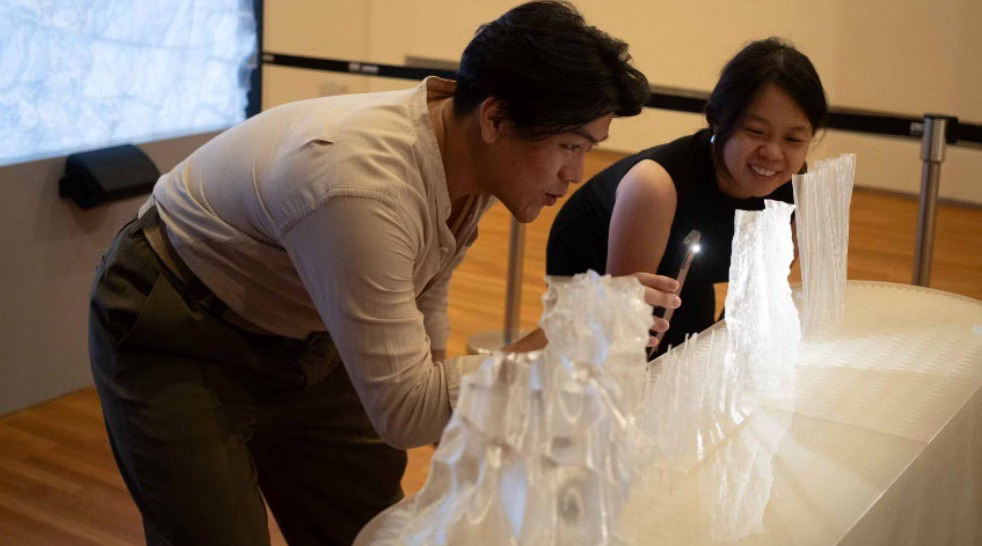Scarce City, an innovative digital journey into art and technology, takes center stage at the National Gallery Singapore from 11 January to 30 March 2025. Created by acclaimed digital artist Elizabeth Mak, in collaboration with the National Additive Manufacturing Innovation Cluster (NAMIC), the exhibition intricately weaves artistic expression, advanced 3D printing, and thought-provoking discourse on climate change. Through immersive theatre and resource-management games powered by cutting-edge body-tracking technologies, Scarce City challenges visitors to rethink scarcity and sustainability. This exhibition not only showcases the intersection of technology and art but also serves as a platform for educating the public on sustainable practices, highlighting the urgency of climate action in today’s society.
Genesis of Scarce City
In recent years, the dialogue around sustainability has intensified, pushing artists and technologists to collaborate in unique ways. Scarce City exemplifies this convergence, prompting visitors to engage with pressing social issues while enjoying a novel artistic experience.
This approach not only transforms visitors into active participants but also creates a compelling narrative that merges personal engagement with global challenges. Through this interactivity, Scarce City encourages critical thinking about resource management, sustainability, and community involvement, vital topics for the future.
Genesis of Scarce City
Elizabeth Mak’s creative journey began with her immersive theatre work at the Albany Park Theatre Project in the United States. Her dedication to community storytelling and societal challenges inspired Scarce City, a reflection of Singapore’s struggles with urban transformation and artificial scarcity. The installation blends interactivity and technology, inviting attendees to take on decision-making roles, confronting resource allocation dilemmas that mirror real-world environmental issues. For example, as participants navigate through various scenarios, they must consider the impact of their choices on both their immediate environment and the global stage.
Moreover, the integration of technology, such as augmented reality and interactive installations, allows visitors to visualize the implications of scarcity in real-time. By presenting complex themes in an engaging manner, Scarce City effectively educates its audience while entertaining them.
By utilizing advanced technology, Scarce City demonstrates how art can serve as a medium for change. The exhibition encourages artists to explore sustainable materials and methods, paving the way for future projects that prioritize ecological impact.
Visitors can appreciate the complexity of this structure not just as a visual masterpiece but also as a testament to the potential of recycling in art. By showcasing how waste materials can be transformed into captivating art pieces, Scarce City inspires a shift in perspective regarding consumption and environmental responsibility.
Furthermore, the project team hosted workshops to engage the community in the creation process, emphasizing inclusivity and educational outreach. These workshops not only provided hands-on experience but also fostered a sense of ownership and connection to the installation, highlighting the importance of community involvement in art.
This approach not only benefits the environment but also sparks conversations on sustainability among audiences, encouraging them to consider their own consumption habits and the importance of recycling.
Moreover, the project team documented their journey, sharing insights and lessons learned through social media and blog posts, further emphasizing the importance of transparency and knowledge-sharing within the creative community.
Additionally, Scarce City has the potential to serve as a model for future exhibitions, showcasing how art can inspire change and foster dialogue on important issues. By focusing on themes of sustainability and community engagement, it paves the way for future artists to explore these vital topics through their work.
This approach transforms visitors into active participants, creating a compelling narrative that merges personal engagement with global challenges.
Reframing Scarcity Through 3D Printing
At its core, Scarce City reframes scarcity as a psychological construct. The installation’s stark visuals and minimalist design compel introspection on human responses to limitation. This theme is underscored by the use of 3D printing, which replaced traditional fabrication methods such as injection molding due to its cost-effectiveness, adaptability, and minimal waste. The decision to utilize 3D printing not only aligns with sustainable practices but also allows for innovative design possibilities that traditional methods cannot achieve, pushing the boundaries of what art can be.
Over 1,700 custom 3D-printed components, crafted from recycled PET filament, form the centerpiece of the exhibit—a 10-meter rock façade. This luminous, rugged structure embodies a harmony of aesthetics and sustainability. The collaborative expertise of Hui Yijian, Additive Manufacturing Engineer at NAMIC Hub@SIT, enabled seamless execution of Elizabeth Mak’s visionary designs, bridging the gap between art and engineering precision. This collaboration exemplifies how interdisciplinary teamwork can lead to groundbreaking innovations in both the art and technology sectors.
The creation process involved intricate steps: printing each component, post-processing, and manually assembling them into a cohesive structure. This meticulous effort underscored the team’s commitment to achieving both visual and environmental impact. Each phase of the project required innovative problem-solving and creativity, contributing to the overall quality and sustainability of the installation. By sharing these behind-the-scenes insights, Scarce City fosters a deeper appreciation for the complexities involved in merging art with technological innovation.
Sustainability at the Heart of Innovation
Scarce City champions sustainability by integrating over 200 kilograms of recycled PET filament into its modular construction. This design not only minimizes waste but also ensures reusability for future exhibitions, aligning with circular design principles. The modular nature allows reconfiguration, extending the installation’s lifespan and versatility while reducing its ecological footprint. Such principles are critical as the art world increasingly moves towards sustainable practices, encouraging artists and institutions to rethink their environmental impact.
Challenges such as printer calibration and material experimentation became opportunities for innovation, reflecting the resilience and ingenuity of the project team. Each challenge faced was met with creativity and determination, showcasing how adversities can fuel innovation and lead to remarkable outcomes. This determination is a crucial lesson for other artists and projects seeking to push boundaries while maintaining a commitment to sustainability.
A Transformative Experience
Scarce City transcends traditional art exhibitions, immersing visitors in a sensory experience that provokes deep reflection on scarcity, responsibility, and environmental coexistence. Its interactive design and atmospheric storytelling foster an emotional connection that resonates long after the visit. By facilitating such connections, the exhibition encourages visitors to take action in their own lives, promoting environmental stewardship and community responsibility.
Scarce City transcends traditional art exhibitions, immersing visitors in a sensory experience that provokes deep reflection on scarcity, responsibility, and environmental coexistence. Its interactive design and atmospheric storytelling foster an emotional connection that resonates long after the visit.
Looking forward, Elizabeth Mak envisions Scarce City as a traveling exhibit, sharing its powerful message worldwide. She also aspires to establish a dedicated 3D printing studio, further pushing the boundaries of immersive, technology-driven art. This vision reflects a commitment to inspire future generations of artists and technologists to collaborate for a sustainable future, ensuring that the messages of Scarce City resonate long beyond its initial exhibition.
Scarce City stands as a testament to the transformative potential of blending art and technology to address pressing global challenges. It calls for collective action and reimagines the possibilities of sustainable design in reshaping our future. As audiences engage with Scarce City, they are prompted to consider their own roles in fostering sustainability and the impact of their choices on the environment, driving home the importance of personal responsibility in the collective journey towards a sustainable world.
Original Source

